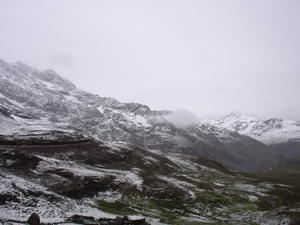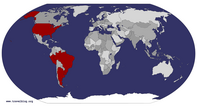Advertisement
Published: April 12th 2007

 Totora to Lares
Totora to Lares
The road to the pass Hello my friends, how are you? I hope this email finds you in good spirits and good health! I am currently in Buenos Aires, a wonderful and lively city and the capital of Argentina. However, this entry will be focused on Machu Picchu and may be quite long for I had many amazing experiences on my way from Cuzco, Peru to Machu Picchu and you may hear about many of them! Lucky you! Just kidding, you may stop reading, of course, any time you wish.
The journey began on the most important day of the year, April 9th, my birthday. A group of brave trekkers left Cuzco early in the morning to begin a wonderful hiking trip that would take us through traditional Andean villages, high mountain passes and unforgettable experiences finally ejecting us from the trail in a town called Ollantaytambo about an hour train ride from Machupicchu Village (Aguas Calientes). Truth be told the first attempt was made to join a trek on the famed Inka Trail but, contrary to the generally spot on advice of the Lonely Planet guide, one cannot simply "get on" to an Inka Trail trip; reservations must be made in advance. Far

 Ipsay Pass
Ipsay Pass
From Huacahuasiin advance. Still, I would not trade the "Lares Trek" we took for anything.
We piled into a small mid-engine Toyota four cylinder van that was by U.S. standards a piece of junk and I confess that had I know the roads we were to take I may never have agreed to get in. Nonetheless, we headed out to a town called Calca where we ate breakfast at a nearby hot springs. Soon after breakfast we began the first stretch of our trip through an ancient canyon called Totora. The canyon was steep and deep and wet from the small, raging creek that had carved through the stone over many millennia. As we walked a stone path build centuries before by the Inkas we marveled at ancient pre-Inkan (12th century) tombs built into the rock faces as high as 15 meters above the canyon floor. For the last part of the morning we hiked up a steep, wet valley where sheep, alpacas and llamas roamed between a few traditional Andean stone homesteads and piled cold, tired and hungry into our van at the apogee of the valley.
Once "safely" in the warmth of the van we sped up a
dirt road towards a snow covered path (because it was more like this at the pass than a dirt road) that would take us to the town of Lares. On our way up and our way down I was constantly astounded by the construction of the road. The only places where concrete existed was where small creeks raged down the mountain cascading from small falls down onto a pad that simultaneously prevented the road from eroding and caused us to drive through 15 inches of water. When we reached Lares we bought some supplies and dried out as lunch was cooked. From our breakfast of eggs and white bread we were not expecting much but were ecstatic to receive corn chowder, half avocados stuffed with carrots and peas and delicious chicken in broth over noodles. Our insides warmed as the sky above consented to our desires for sun that might warm our outsides and dry us out a bit. As we began our hike, so did our amazing cultural immersion.
The villagers outside of Lares and all the way until Ollantaytambo speak Quechua, an indigenous language to the Andean region today spoken by about thirteen million people in Bolivia,
Peru, Ecuador, Northern Chile, Argentina and Southern Columbia. The language is old and was the official language of Tawantinsuyu, the Inkan Empire, which explains its breadth. The ancient traditional language of Peru is nothing like the more familiar romantic languages I am accustomed to but luckily, our guide Paull spoke Quechua (along with French, English and Spanish) so we were able to communicate quite easily. Still, it was far more fun to struggle through Spanish with the small children, or try to understand each other through the Quechua-English barrier. The first group of homes we passed along the trail were beautiful stone with traditional thick grass roofs over a solidly constructed timber frame. The insides of the homes were dark but usually had two outlets, one for a radio and one for a bare light bulb that filled the home with blinding light. On the roof there was an elevated patch of about two feet by two feet to let the smoke out from the cooking fires. Though the houses had this, a thick scent of wood smoke persisted and the timber roof frames were uniformly sooted.
Outside of each home was a sink with a faucet and running
water. Out of each spigot surged cool, clean and massive amounts of springwater. Most of the homes had pipes tapped into mountain springs high above so by the time the water reached an outlet it was ready to explode into the sinks. Outside of many of the homes was a stick projecting like a flagpole with some dried grasses and flowers attached to the end in a bouquet type fashion. This marker signified a chicha house. Chicha is a traditional heady corn beer made from boiling corn and red and yellow jello together and then letting the mixture ferment. It was quite delicious but we decided not to have to much after learning it was used for medicinal purposes as a diuretic. Still, as we walked along the path we encountered groups of people sitting and drinking liter cups while laughing and yelling amiably at each other. I asked Paull how much people drank a day to which he replied about six or seven liters. No wonder they were happy. Add that to the large chaw-like bundles of coca leaves that most had shoved into their cheeks and you have a party to rival any.
As we left the
first town the hills rose up around us and gave birth to the majestic, cragged peaks beyond covered in snow. Llamas, alpacas and sheep roamed the communal hills like swallows, the un escorted group suddenly changing direction but never breaking pack and never intermingling with other groups. They seemed to know their owners flock. The pastoral land was also heavily tilled in neat, steep rows of potatoes. Each variety had different flower and the hills were alive with color. I do not remember the exact names of the tubers but there were red, brown, sweet and golden potatoes all around. Peru has over 4000 varieties of potato!!!
As we hiked closer to our evening destination, a small town called Huachuasi at 3800 meters, we began to see more and more traditional stone homes about twenty-five feet by fifteen, much larger than those lower in the valley. The dress of the people began to appear much more traditional as well, exhibiting brightly colored, beautifully and intricately woven ponchos, caps and dresses. As we learned, each article of clothing is different and not only varies in style with the village and region where the weaver is from (both men and women
weave but most often the women) but also with their personal experiences, family history and important symbols like grains, birds and tubers. It was wonderful. Children came running out of their homes to greet and stare at us, we foreigners in their lands. But mostly they ran along or in front of us speaking mostly Quechua to Paull and saying "Hola" "Ciao" and "Buenos tardes" to the gringos. Of course, they all knew the requisite "Propina" (tip) which they happily chirped after we took their pictures. Luckily we had plenty of chocolate, wafer cookies and smiley face stickers to satisfy an army.
After dinner we stepped from the dining tent to find the stars so bright and close that you could almost reach out and pluck them from the sky. High in a mountain valley where even the moon was shielded until the early morning, the millions of stars in sight and the milky way smiled down on us. To my delight I also saw for the first time the Southern Cross on the horizon.
The next morning we awoke early. Few people were out save the children gathering water from the river but fires burned warmly in each house, evaporating the frost that had accumulated on the top of the thatch the evening before making it appear as though the entire valley steamed. After a delicious breakfast of pancakes and a poppy-seed cake with orange flavored frosting (complete with my name spelled with a backwards "S") for my birthday the day before we set out to conquer a snow capped 4400 meter pass called Ipsay. We awed as we ascended, coming closer and closer to the magnificent and rugged peaks. Even at such an altitude some brave flowers poked up through holes in the snow, persisting in their frozen environment. We breathed heavily and shallow, our bodies yearning for more oxygen than our breathing afforded. As we reached the apex we stood in a saddle between two peaks, looking down on Huacahuasi to the east and a beautiful green valley to the west that held the village of Patacancha.
Perhaps the most amazing aspect of our day was a young boy named Martin who caught up to us about and hour outside of Huacahuasi. Martin, a thirteen year old high school student from Huacahuasi (a town that has no high school), was going to school. The much closer and downhill high school in Lares was full, so he could not enroll there. Thus, every Monday Martin walks over the pass to the next town of Patacancha and every Friday he walks back to Huacahuasi. Martin climbed with a small back pack, a traditional satchel made from rolling one´s possessions into a thin blanket and then tying it around the shoulders, his vivid poncho and hat, a sweater, a pair of Adidas warm-up pants and the same sandals that every Peruvian seems to wear. A flat leather sole with ridges about as deep as a Ruffles potato chip, a heel strap and two crossed straps over the top of the foot. He tramped through the snow and mud and stone with us. His feet must have been leather, long ago loosing any fragility that feet might initially have. I shuddered with amazement.
We slumped wearily into Patacancha our legs, backs and shoulders sore from the climb. The next two days would bring us closer and closer to the world of Machu Picchu and tourists but this entry is long enough so I will spare you.
Peace and love my friends, Yours, Simon
Advertisement
Tot: 0.067s; Tpl: 0.011s; cc: 9; qc: 44; dbt: 0.0435s; 1; m:domysql w:travelblog (10.17.0.13); sld: 1;
; mem: 1.1mb









cam2yogi
Cameron Karsten
Bueno, Bueno, Bueno y Bueno
Beautiful. I pinche miss you my friend, and continue kicking ass in the dreams of living